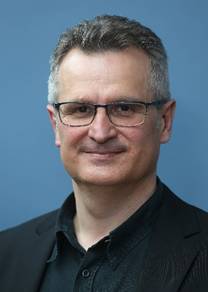
| Date | 7th Dec. 2018 |
| Time | 10:00-11:30 |
| Venue | Room 333, Building 5, Yuquan Campus |
| Speaker | Prof. Michel Destrade (NUI Galway, Ireland) |
| Abstract | We show that a smooth giant voltage actuation of soft dielectric plates can be obtained, in principle, by exploiting the snap-through behaviour of the voltage-stretch loading curve to deliver a large stretch prior to electric breakdown. However, the soft dielectric is likely to first encounter the plate wrinkling phenomenon, as modelled by the onset of small-amplitude sinusoidal perturbations on its faces. We provide an explicit treatment of this incremental boundary value problem and derive closed-form expressions for the two limit cases of very thin membranes (with vanishing thickness) and of thick plates (with thickness comparable to or greater than the wavelength of the perturbation). In addition to the expected buckling mode coming from the purely elastic case, we discover a second mode occurring at large voltages in extension. We find that plates always wrinkle anti-symmetrically, before the symmetric modes can be reached. We make the link with the classical results of the Hessian electro-mechanical instability criterion and of Euler buckling for an elastic column. We also investigate the finite bending and the associated bending instability of a dielectric slab subject to a combination of applied voltage and axial compression. We show that the applied voltage has a destabilising effect, while the effect of the axial load is more complex: when the voltage is applied, changing the axial loading influences the true electric field in the body, and induces competitive effects between the circumferential instability due to the voltage and the axial instability due to the axial compression. We even find circumstances where both instabilities cohabit to create two-dimensional patterns on the inner face of the bent sector |
| Speaker | Professor Michel Destrade is Chair of Applied Mathematics at NUI Galway; Adjunct Professor at Zhejiang University and at University College Dublin; Directeur de Recherche at the French National Centre for Scientific Research (on leave) and a member of the International Brain Mechanics and Trauma Lab at Oxford University. He is Associate Editor of many prestigious international journals, Reviews Editor for Proceedings of the Royal Society A and Contributing Editor for International Journal of Non-Linear Mechanics. He is acknowledged internationally for his active participation in collective articles, graduate courses, special issues, editorial boards and international bodies. In Galway he is involved in a structured effort to make progress in the fields of nonlinear electro-elasticity, acousto-elasticity theory, nonlinear wave theory and their applications to soft tissues and soft dielectrics, with competitive funding (European Commission; Royal Society; British Council; Science Foundation Ireland; Irish Research Council, etc.), an output of 6-10 articles/year, numerous talks, strong press coverage (The Irish Times, New Scientist, Science, Wired, La Recherche, etc.), a large network of highly influential collaborators. He has coordinated several advanced courses, workshops and conferences locally and abroad. His expertise is regularly called upon to evaluate articles, grant proposals, promotion bids, MSc and PhD theses, etc. He has authored 3 book chapters and 120+ publications in high-impact international journals with 60+ international collaborators. His h-index is 32 and his citation count 3,200+ (Google Scholar). |


